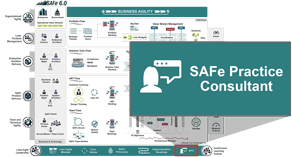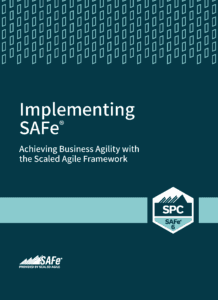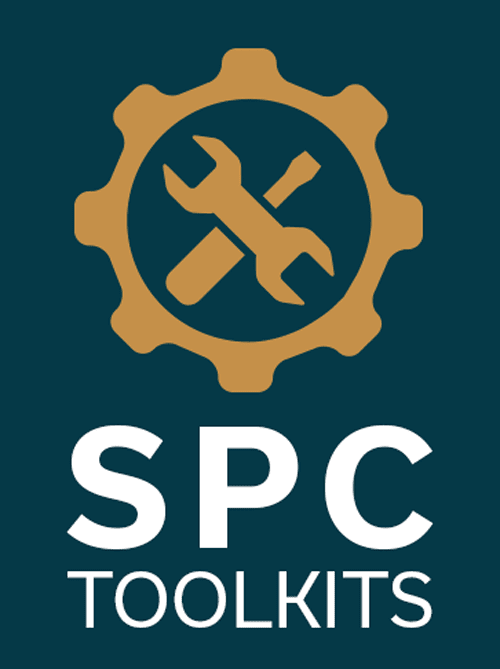
… the people who are crazy enough to think they can change the world are the ones who do.
—Apple’s 1997 Think Differently Campaign
Ready to start training?
Use our finder to explore current offerings or learn more about a specific course
SAFe Practice Consultant
SAFe Practice Consultants (SPCs) are certified change agents who combine their technical knowledge of SAFe with an intrinsic motivation to improve the company’s software, systems, and Agile business processes.
SPCs play a critical role in successfully implementing SAFe. They come from numerous internal or external roles, including business and technology leaders, portfolio/program/project managers, process leads, architects, analysts, and consultants.
Details
Business Agility is the ability to compete and thrive in the digital age by quickly responding to market changes and emerging opportunities with innovative, digitally-enabled business solutions. For traditional enterprises, recognizing the fact that success is now enabled by the ability to create these solutions is a bit of a ‘wake-up call’ or even an existential crisis. Even for companies that were born in the digital age, future success cannot be assured. SAFe Practice Consultants (SPCs) work within and across organizations to provide new methods and practices that connect the entire enterprise with the principles that enable Business Agility. This critical role answers a vital need to build the future of work.
To achieve meaningful and lasting change, author John P. Kotter notes that stakeholders need a “sufficiently powerful guiding coalition”. [1] Such a coalition requires:
- Leaders who can set the vision, show the way, and remove impediments
- Practitioners, managers, and change agents who can implement specific process changes
- Sufficient organizational credibility to affect change
- The expertise needed to make fast, intelligent decisions
In enterprises utilizing SAFe, these coalitions require experienced and trained SPCs.
Responsibilities
As knowledgeable change agents, SPCs have a primary role in many of the 13 critical moves described in the SAFe Implementation Roadmap. They also must work beyond the roadmap as experts and coaches that help the organization achieve business agility. Doing so requires fulfilling a broad set of responsibilities, as seen in Figure 1.
Embodying a Lean-Agile Mindset
SPCs lead change conversations across multiple business departments and organizational hierarchies. To be credible and effective, they must speak with knowledge and competence. In addition, to inspire changes in the behaviors of others, SPCs first create change in themselves. Required mastery and knowledge includes:
- Exhibit the Lean-Agile Mindset – To help others achieve a Lean-Agile Mindset, each SPC must lead the way. This will be a continuous journey each SPC must choose to take. SAFe SPCs model the values and principles of Lean Thinking and the Agile Manifesto in their daily interactions.
- Demonstrate the SAFe Core Values – By exemplifying respect for people, alignment, transparency, and relentless improvement, SPCs demonstrate a common value system and inspire others to the same beliefs. SPCs feel a personal accountability to live the core values and lead by example.
- Utilize the SAFe Principles – SPCs have internalized the SAFe Principles and know how to use them to initiate and sustain conversations that inspire change. They sense the issues hindering agility and apply their understanding to clearly communicate the principles that inform transformed behavior and practices.
Leading the Change
SPCs know the ‘job that must be done’ to achieve the change vision. They communicate the business need, urgency, and vision for change with the assistance of critical SAFe training and assets that are purpose-built to provide a proven path to organizational change. SPCs know how to apply the right asset at the right moment, utilizing the full breadth of SAFe as their implementation toolkit. Change activities include:
- Communicate the vision for change – SPCs know that change involves subtle overlapping stages. They guide teams at multiple levels throughout the organization, handling the cycles of change and communicating the vision as each emerges. To communicate clearly and effectively, SPCs partner with enterprise leaders to articulate the path forward and to coach leaders. When change is not flowing through the organization, however, SPCs identify opportunities for improvement.
- Maintain the Guiding Coalition – As the transformation grows, so does the need for the guiding coalition. SPCs assist the organization in building and growing the LACE and Value Management Office (VMO) and help identify the proper individuals for those organizations. SPCs also encourage emerging members of both groups to become SPCs to understand the transformation fully. New leaders will emerge throughout all layers as the organization becomes more transparent. SPCs identify and align them into a growing network of connected guiding coalition teams. (see the Extended Guidance article for an example)
- Maintain the transformation backlog – SPCs throughout the organization, the LACE, and the VMO, align on transformation backlogs, enabling a shared vision for the changes required to improve flow, advance skills, grow role-based competencies, grow mindset, and more. Teams, trains, LACEs, and Portfolios all have local improvements. SPCs enable alignment through active communication and energy that mitigates complacency and silo-based optimizations. SPCs encourage experimentation with practices to gain the right wins for the opportunities at hand, applying SAFe’s Principles, Values, and Lean Thinking to keep experimentation connected.
- Launch Exemplar Communities of Practice (COPs) – As the SPC community grows through supporting an organization, they will work together to identify their strengths. SPCs often form a CoP to share knowledge and support each other. SPCs also help create and enhance other CoPs, enabling collaborative environments that furthers the organizational ability to problem-solve, learn and retain top talent.
Implementing SAFe
The implementation roadmap assists SPCs in the tactical steps required to lead the change, ensuring that each ‘next step’ is done without ignoring previous changes that may still require attention. Treating every implementation as if it were their first, SPCs transfer their enthusiasm, energizing the new participants.
In so doing, SPCs apply and often lead many of the critical moves of the SAFe Implementation Roadmap as described below:
- Reaching the tipping point – They communicate the business need, urgency, and vision for change.
- Create a Lean-Agile Center of Excellence (LACE) – SPCs assist the LACE with building and executing the transformation backlog.
- Training executives, managers, and leaders – They socialize the new concepts and provide orientation and overview training, specifically teaching all directors, managers, executives and leaders associated with the transformation in Leading SAFe.
- Lead in the Digital Age – SPCs facilitate modules of the Leading in the Digital Age series for leaders, managers, and stakeholders, continuing after these modules to help leaders form and practice new behaviors and methods.
- Organize around value – Working with stakeholders to understand the flow of value, SPCs facilitate the identification of Operational Value Streams, Development Value Streams, ARTs and Portfolios to find those that are the most opportunistic for launch.
- Create the implementation plan – SPCs participate in creating a plan for the rollout, communicate upcoming changes, and establish metrics.
- Prepare for the ART launch – SPCs help the LACE plan and prepare for the ART launch. They coach leadership and help facilitate the creation of new Agile Teams. They also train or source training of executives, leaders, Agile teams, and specialty roles—such as Product Owner, Product Manager, Scrum Master, and Release Train Engineer (RTE). They also assess and evolve launch and backlog readiness.
- Train teams and launch the ART – SPCs often directly plan and execute ‘quickstart’ or other rollout strategies. They train or source training for teams and participate in initial, critical events like PI Planning and Inspect and Adapt (I&A). SPCs help establish the ART launch date and calendar for ART and Team events.
- Coach ART execution – The SPCs coach leaders and stakeholders to build and maintain the Vision, Roadmap and backlogs. They coach teams, Product Owners, Product Managers, Architects, and RTEs. They guide the shift from project-to-product with a focus on Customer Centricity and Design Thinking as part of Agile Product Delivery. They also participate in Coach Sync and System Demo, facilitate I&A and follow-up on improvement items. Finally, they help teams establish a DevOps culture and mindset, the Continuous Delivery Pipeline, infrastructure, and associated built-in quality practices.
- Launch more ARTs and value streams – SPCs work to enable new change agents to increase organizational capacity to support new value streams, start more ARTs, and expand the reach of the LACE. They communicate progress and highlight early accomplishments.
- Enhance the portfolio – Once Lean-Agile practices gain momentum, SPCs can socialize and optimize those practices in the portfolio level, including Portfolio Vision, Lean Budgets using Participatory Budgeting and Guardrails and Lean Portfolio Management.
- Accelerate – An enterprise’s SAFe journey doesn’t end with the launching of trains and the adoption of Lean Portfolio Management. SPCs have expert mastery of the seven competencies of the Lean Enterprise and how they contribute to achieving Business Agility.
Coaching Flow
SPCs have a critical role in enabling all members of an organization to understand the flow of value and how to Make value flow without interruption (SAFe Principle 6). Coaching flow effectively requires SPCs throughout the organization to:
- Facilitate value stream mapping – SPCs facilitate Value Stream Mapping exercises to identify and maintain the overall flow efficiency of a full value stream or portion of a value stream. They use data from the teams, the tools, and the outcomes of improvement items to maintain the value stream maps, improving the continuous delivery pipeline.
- Establish the Kanban systems – SPCs help teams understand and utilize Kanban boards and practice through each layer of SAFe, including Agile Teams, ARTs, Solution Trains, and Portfolios. SPCs help create connections throughout the Kanban systems, enabling strategy to flow through execution.
- Measure flow – SPCs understand flow metrics and how they work alongside competency and outcome metrics to facilitate enterprise flow improvements. They help the organization to use quantitative and qualitative data to validate flow improvements and inform further steps. SPCs help create routine leadership participation in improvement activities as well as a certain degree of decentralized decision-making to enable the knowledge workers to directly improve their work environment and achieve faster flow, encouraging transparent-to-all measurement along the way.
- Apply the Flow Accelerators – The SPC utilizes Flow Accelerators to improve flow performance in the context of their organization. Applying the Flow Accelerators has significant differences depending on the level at which they are applied: Team Flow, ART Flow, Solution Train Flow, and Portfolio Flow. The SPC has many opportunities available across various SAFe events, workshops and trainings to accelerate flow ongoing.
- Grow a flow mindset – SPCs actively participate in community discussions on improving flow through the system. They bring facts to conversations, enabling flow visualization and resolving impediments. Making flow visible is a multi-faceted effort that involves extensive use of flow metrics, information radiators, tooling, and productive communication around the issues of flow. SPCs foster the interactions between leaders and teams, establishing healthy visibility and Gemba. SPCs use 1:1 and small group discussions consistently to grow the flow mindset outside of workshops and events as the organization evidences the wins that the flow improvements introduce to their value delivery. Gradually, a shared mental model of flow is established that helps the organization navigate through their journey of flow optimization and transformation.
Accelerating Business Agility
SPCs keep the long-term business agility vision moving. They enable business agility, not by over-optimizing a piece of the system, but by optimizing the system as a whole. Additionally, SPCs measure and cultivate competencies at all levels, run workshops, foster training opportunities, and assist new SPCs in their roles. SPCs sense and create opportunities to:
- Extend agility across the business – Organizations may begin their SAFe journey within a specific business department, usually within IT, Cyber-physical, or Digital departments. SPCs find opportunities to apply patterns of agility throughout their organization, fostering new areas of transformation. Utilizing Business and Technology patterns of those who have come before and identifying and sharing new patterns, they help their entire enterprise in achieving full business agility.
- Measure and Grow the core competencies – SPCs help companies achieve business agility by measuring and growing the core competencies at all levels. They work with other SPCs to align up and down and across the enterprise to create systemic improvement tidal waves. They coach competency improvements, maturing others to be able to simplify the inherent complexity that comes with scale.
- Expand the SPC pool – As the SPC pool grows, seasoned SPCs assist new SPCs in building their confidence and understanding while supporting the transformation. To achieve the breadth and depth of Agile leadership throughout the organization as the transformation grows, SPCs must enable other SPCs.
- Sustain the change – As needed, SPCs will continue to lead Value Stream and ART Identification workshops and discussions to organize and reorganize around value. Partnering with Lean-Agile leaders throughout the organization, they’ll continue to advance the guiding coalition and the change process. They also participate in and lead trainings and workshops to enable business growth, including design thinking workshops, epic writing, story mapping, and more. While maintaining the foundation that started during the first Agile experiments, they help apply test-and-learn techniques to new spaces.
The tactical items above will comprise the new way of working, with cadence and alignment becoming habits. SPCs will continue to keep new ways of working meaningful and flow-based. SPCs know how to listen for the signals in their organization that indicate stunted growth and improvement. They use these signals to pull people together across solutions, creating transparency toward shifting conversations from simply tracking work to strategic decision-making. SPCs must also be aware that this is a value and principle-based system, and that events and activities must stay activated. The new thinking must be anchored by SPCs and the larger guiding coalition in the mindset and culture of the organization. Without this, teams and leaders will invariably fall back into old behaviors. Multiple roles in the organization maybe SPCs, and each are critical to this continuous involvement.
How many SPCs do you need
At first glance, the responsibilities above seem daunting. No single SPC could accomplish all this alone, as the knowledge and skills of an SPC can’t be limited to a few select people within a scaled enterprise. For example, an SPC who coaches executives often differs from an SPC who coaches technical practices to Agile teams. Instead, many leaders across the emerging Lean-Agile business must master these distinctive new competencies. This means most companies will require many SPCs (as many as 5+ per 100 practitioners) to drive and sustain the implementation.
Achieving SPC training and certification

SPCs must be trained for their new role and certified to be enabled to train others. They need to acquire the skills and tools to execute their responsibilities and coach and teach others to implement and support the change. The best way to achieve this is to take the Implementing SAFe with SAFe® Practice Consultant (SPC) certification class. This four-day course prepares SPCs to become the change agents who lead the transformation. Attendees learn how to effectively apply the principles and practices of SAFe and organize, train, and coach Agile teams. They also learn to identify value streams, identify and launch ARTs, and help build and manage an Agile portfolio. To make the role-based training required across the organization practical and cost-effective, Scaled Agile, Inc. supports a train-the-trainer, fan-out model, licensing SPCs to teach SAFe courses that support the other key roles in the implementation. This provides an affordable training strategy and supplies the trainers needed to achieve the mission of company-wide change.
I’m an SPC. Now What?

After passing an exam, attendees become certified SPCs, gaining access to various helpful SPC resources to facilitate SAFe adoption. They will also be licensed to teach the courses listed here.
Learn More
[1] Kotter, John P. Leading Change. Harvard Business Review Press, 2012.
Last update: 4 May 2023